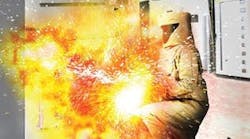Walk into almost any industrial facility, and an hour later you can walk back out with a list of Code violations. How many can you spot in your facility? We’ll look at some common Code violations, why they matter, and what requirement(s) they violate. The first one on our list is arguably the most common.
Enclosures with unused openings
Equipment changes, design upgrades, and reusing salvaged enclosures are circumstances leading to this Code violation.
An enclosure serves several purposes. Obviously, an open hole in an enclosure listed for wet locations will violate the listing. But what about your typical NEMA 1 enclosure in a typical application?
Take a close look at any metal enclosure. The walls are much thicker than needed to merely provide a space in which electrical components can go. Look at the seams; why are they that significant? Manufacturers could make knockouts much easier to remove, too. Why don’t they?
One basic purpose of any electrical enclosure is to help muffle an arc flash or other event. If you’ve got a half-inch opening or two in the bottom of a box in a typical application, it’s going to focus that energy through the hole instead of help contain it.
Another basic purpose is to protect people against contact with energized parts. Granted, people shouldn’t be sticking their fingers through holes in enclosures, but there are other ways incidental contact can be made.
Enclosures also protect against rodents and insects but not with an unused opening — even a small one.
Unused openings must be closed in a manner that provides protection substantially similar to that of the enclosure wall in which the opening exists [110.12(A)]. This requirement rules out some materials that are sometimes used to close the openings.
Working space is inadequate
This is a frequently dangerous and usually expensive violation. The key idea here is “adequate.” The tables in OSHA and in NEC are mere starting points. They aren’t — contrary to what is often understood by non-electrical types — something you should try to meet if you can.
And the requirement is not, as is commonly believed, 3 ft in front of a panel (regardless of the voltage or the equipment inside it) or with no regard to the space to the sides, below, or above. The point of “adequate working space” is to provide enough space to safely work on the equipment.
When determining how much space is enough, it’s not a matter of looking something up in a table and calling it a day. It’s a matter of determining how much space actually permits ready and safe operation/maintenance [110.26] of that particular equipment as installed in that particular location. For example, the space may need to allow for a maintenance cart, portable lighting, and two maintenance techs.
When determining the working space, you must consider:
Minimum clear distance [110.26(A)(1), (2), and (3)]. Absolutely nothing can be put in front of the equipment up to this minimum distance, and that includes pallets and other things “that we can always move if you electricians need to get in there.” A best practice is to mark this distance permanently on the floor.
Width [110.26(A)(2)]. The NEC’s stated minimum is 30 in. or the width of the equipment (whichever is greater). But refer again to 110.26. Maybe a panel is in a corner with a wall of equipment 30 in. from the building wall. The allotted space meets 110.26(A)(2) but is clearly inadequate.
Height [110.26(A)(3)]. The NEC’s stated minimum is 6½ ft from the floor (or grade) or the height of the equipment (whichever is greater). But refer again to 110.26. An item installed 6 ft, 6 in. above the floor (under a panel) meets 110.26(A)(3), but if it is likely to interfere with maintenance, it’s a Code violation. Also, some things should simply not be placed above electrical equipment regardless of height. Examples include: windows, water heaters, pressure relief valves, grated walkways, and fire hose reels.
Conductor bend radius exceeded
This is a classic error in plants where existing equipment, raceway, cabinets, finished walls, or other items create a tight fit when adding a circuit — especially if adding large conductors.
A maintenance technician with an electronics background may diligently use needle nose pliers to make nice 90° bends in the wiring so it looks neat. That may be fine for the breadboard wiring he encountered in electronics classes, but it can easily destroy most types of signal cables. Worse, it ensures premature insulation failure when done with power wiring.
Don’t exceed the bend radius at any time, whether pulling the conductors or “finishing out” the enclosure [110.3]. Once the radius is exceeded, the conductor no longer meets its listing requirements. Also, remember to keep in mind the many requirements for protecting conductors from damage, sprinkled in seemingly every Code article. Pay attention to storage practices as well.
Raceway used as support
This is often done by a non-electrical contractor adding something such as a public address system or security cameras. “Gee, look at all this electrical pipe. We can just cable tie onto that!”
Going down this path would lead to mechanical failure of raceway systems as things get piled on to existing raceway and overload the supports. So the NEC simply bans it except under the three conditions identified in 300.11(B).
From a maintenance standpoint, what happens if you need to replace conductors or do an equipment move? In fact, don’t just abide by the “not used as support” restriction of the NEC, but keep those other systems a good distance from raceway wherever practical.
Grounding instead of bonding
This is a common cause of downtime attributable to a Code violation. Grounding does not create an equipotential plane, does not eliminate differences of potential, and does not provide “the path of least resistance.” Bonding does the first two of those; the third is fiction.
See Art. 100 for the definitions of bonding and grounding. See Art. 250, Part V for bonding requirements. Review Kirchoff’s Law of Parallel Circuits if you don’t completely reject “the path of least resistance” theory.
Poor workmanship
This violation of 110.12 seems to sneak up on industrial installations, unnoticed until its costliness hits home.
Over time, a nicely laid out cabinet can become a bird’s nest of wires for a variety of reasons. Take the emergency replacement, for example. An old control system fails, so the process can’t run. But that controller is no longer manufactured.
So the system engineer locates a different type of controller and has it overnighted. It’s not a direct replacement, and the wiring is very different this time around. For one thing, it eliminates many discrete components (e.g., all those relays that were nicely wired up).
The pressure is really on to get the equipment back in service. There’s no time to label things, plan the wire routing, or develop drawings. The installing electrician figures out the wiring on the fly. The production supervisor promises, “We’ll let you go back later and pretty it up,” but that never happens.
Months later, there’s a problem. Maybe it’s in one of those hastily made connections. Maybe it’s any of a thousand different things, but who can tell?
Is there always enough time to redo a job, but never enough time to do it right? Avoid the lost time of rework by doing a job right, regardless of the momentary pressure.
You can reduce installation time by doing as much “offline” pre-work as possible. For example, download the manual right after ordering the new equipment. Then create installation and connection drawings, plan wire/cable routing, and prepare the wire labels. There is plenty of time to do this while the equipment is on its way.
Code compliance
Instead of asking how to make the plant safer and maintenance more efficient through Code compliance, some managers try to see what they can get by with. If the electrician pushes hard enough on a particular violation, a small battle can be won. Too often, though, management plays a losing game of “Code chicken.” You can change this into a winning game by highlighting the critical Code requirements we’ve discussed.
You can show non-electrical managers that the small cost of Code compliance pays huge dividends. Instead of seeing Code compliance as costly nit-picking, they’ll understand why it’s important to join you in making the facility safer and more reliable through Code compliance. If they are already onboard, you can reinforce their positive decisions with this same discussion.
Lamendola is an electrical consultant located in Merriam, Kan. He can be reached at [email protected].





